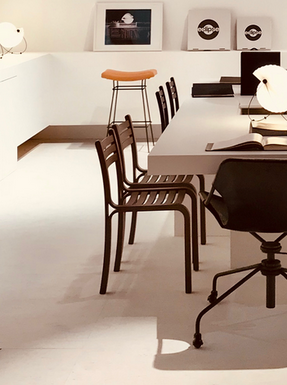
Objekto Gabi Chair
GABI CHAIR
GABI CHAIR
Designed by Reno Bonzon
Excited by the success of his Gaivota rocking chair, Renaud Bonzon take up, in 1990, the challenge of any furniture designer: to create a chair that is both beautiful, of high quality and affordable.to create a chair that is both beautiful, of high quality and affordable.
The plywood technique he was exploring at the time fascinated him. This technique enabled him to use a minimum quantity of material while creating comfortable curves. He chose that way to create his first chair.
DESIGNER
RENO BONZON
Reno Bonzon, French but naturalized Brazilian recently, is a former pupil of the Boulle School and graduated in Psychology from the University of Paris.
Located in Ubatuba, on the south coast of São Paulo, since 1986, he draws and manufactures his creations in his own joinery workshop. His work is widely based on the work of wood, and particularly on the technique of lamellate-stuck (technical which he introduced in Brazil).
More recently, with Ligia Miguez, jeweller graduated from the School of Camargo de Renato, there works also explore the iron and aluminium material properties? .
The emblematic part of the work of Reno Bonzon is surely the rocking chair "Gaivota", probably the object more rewarded in Brazil, combining aestheticism, comfort and ergonomy.
Award winner in 1988 of the Museum of the Brazilian House prize and award winner the same year of the MOVESP prize, this rocking chair was selected in 1990 to represent the Brazilian creation of furniture at the Biennial of Design of Brazil.
The Jury of the Museum of the Brazilian House award particularly underlined the "principle of manufacture which gives to the product its great lightness" like "the aesthetic qualities combined with the ergonomic factor".
The drawing of the armchair, its sinuous curves, irrevocably evokes the movement of rocker, even presented statically on a photograph.
The base of lamp "Nuala", also reminds the characteristics of his creations: elegance and simplicity. Reno Bonzon and Ligia Miguez, develop also together objects made of aluminium, iron and wood.
The couple signed a range of forks and spoons of cast aluminium recycled called "Folha", "leaf" in English, distributed in many countries. The "Galho" lamp, "twig" in English, was selected to be part of the International Design Book 2000 by Ingo Maurer.
INFORMATION
PRODUCTION
Made in France
USE
Indoor & Outdoor
KEY FEATURE
A key feature of the Reno Bonzon's Gabi is to combine only two parts: sides and crosspieces. Unlike many chairs, these crosspieces themselves constitute both seat and back and structure the whole frame. The triangle formed by the junction of the three plywood side stripes give elegance and character to this light, stackable and very resistant "bistrot" chair.
WEIGHT
3 Kg
COMPOSED OF
Side And Crosspiece
DETAIL
A key feature of this chair is to be composed of only two elements: side and crosspiece. Unlike many chairs, these crosspieces themselves constitute both seat and back and structure the whole frame. Another remarkable feature that brings both elegance and character to this chair is the triangle formed by the junction of three plywood stripes that constitute the side of the chair.
A stripe for the back leg and the back forming a slight curve, another one for the back, the seat and the front leg, which forms an "S" and the last one for the back leg, the seat and the front leg forming a "U".
Besides the originality of this assembly, it also provides flexibility to the chair. Although this is not recommended, it is difficult to resist the urge to swing on the back legs. In this case, it creates a great tension at the junction of back leg / seat / back that is mostly absorbed by the triangle which will slightly deform without losing strength.
In 1990, year of its creation, the Gabi chair won two prestigious design awards in Brazil, the MOVESP prize and the one of the Museo da Casa Brasileira. At the same time comfortable and elegant in its composition it is also lightweight, stackable and very resistant. Renaud Bonzon used it for many years in his Cassis restaurant in Sao Paulo.









